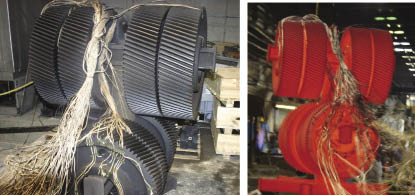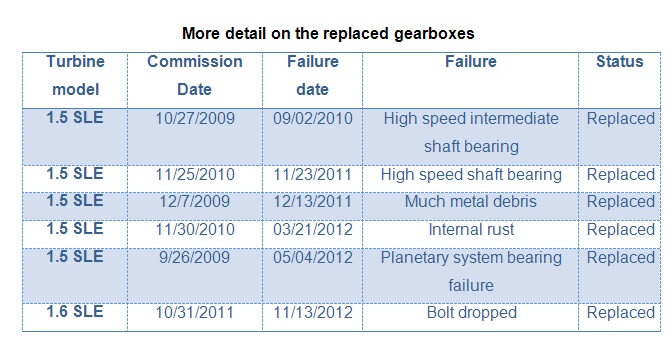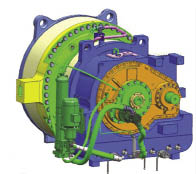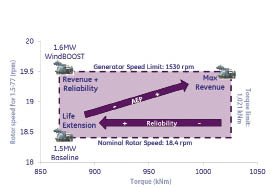GE has given its gearboxes a significant reliability boost in the last few years thanks to technical developments, extensive field and lab testing, and contributions from key suppliers. The results are being applied to a more reliable gearbox. This universal design will provide an upgrade and more capable field replacement for older turbines.
Kurt Goodwin • Executive Manager, Drives & Structures COE • www.ge.com
A joint project

Instrumented manufacturing trials can reveal sensitivities that need addressing. Engineers are taking a range of temperature measurements on the gears as they are being carburized and heat treated. The testing confirmed that minimum spacing is needed to avoid local thin-case areas that come from inadequate cooling flow in the quench tank. This lesson has been applied to all future gearbox requirements.
One proof that GE gearboxes have improved their longevity is demonstrated by one of the jointly developed gearbox models. Of the 2,782 installed since 2008, only six gearboxes have failed. And of the six replacements, three were due to maintenance or rust issues, not gearbox-design issues. This is the lowest replacement rate of any brand over the same timeframe.
The accomplishment is due in part to partnerships. Few companies do everything in house, so GE has reached out through a joint development arrangement with the Nanjing Gear Company to tap its expertise in manufacturing wind-turbine gearboxes. An example of that expertise is the company’s response to a shallow induction case hardening that was identified as the source of some problems with a different supplier. Nanjing quickly developed an excellent automated center inductor to solve the problem. Life and field tests show the response a proven fix.
The partnership has resulted in improved materials and components including:
- Induction hardening for ring gears to significantly improve their strength, life, and a resistance to wear.
- Ductile cast-iron housings provide better performance against shock than grey cast iron.
Work with several suppliers and sub suppliers has also addressed a key past issue that many in wind struggled with – cracks in gears starting from inclusions or contaminants in the steel. Since 2008 the gearboxes make use of a proven supply of clean steel and rigorous control of material specifications. For instance, from 2008 to July 2013, no gear teeth have failed from insufficiently pure steel in more than 3,000 running units.
The universal gearbox

Specific failures from a 2,807 turbine fleet baseline model from which the “Universal Gearbox” will be built.
The company’s effort has lead to a gearbox design team that focuses on creating a universal gearbox to support the existing fleet. Such a design allows for inventory simplification by making one gearbox compatible with multiple turbine models. This development also means a 40% reduction of the projected gearbox failure rate. The gearbox will be available for GE models 1.5-70, 1.x-77, 1.x-82.5 and 1.6-87.
Modifications for easier up-tower repair are also in the works, leveraging field experience, lessons learned, and best practices across the existing installed base to ensure advance up-tower repair and serviceability.
The new gearbox will sport a range of improvements over the designs it replaces. Inventory simplification will be one because one design will work in several turbine models. Design for Serviceability disciplines will be implemented to make certain components of this gearbox repairable up tower rather than down tower.
The improvements should boost the predicted gearbox system reliability by over 10% over 20 years, which varies by turbine model and site specific conditions. From a technical perspective, this means life-limiting components, such as planet bearings, get a design life increase of over two years. For example, slightly over-sizing the gearbox allows a +17% torque improvement on 1.5 SLE models.

The universal gearbox, in CAD form here, promises greater dependability thanks to years of improvements, such as more accurate heat treating.
F rom a performance perspective, the more capable gearbox provides an option to translate increased torque to increased performance, up to +7% in MWh/year. And from an operational perspective, improved reliability means a 40% reduction of the project gearbox failure rate, depending on what model it replaces.
rom a performance perspective, the more capable gearbox provides an option to translate increased torque to increased performance, up to +7% in MWh/year. And from an operational perspective, improved reliability means a 40% reduction of the project gearbox failure rate, depending on what model it replaces.
This combination of improvements also gives owners the option of boosting their AEP, or keeping the same power outputs to further reduce the service on their fleet, or some combination of the two. The accompanying illustration suggests some AEP and life values possible for the 1.5-77 model turbines.
A universal gearbox prototype for a 1.6-87 turbine has shown promising results especially with regard to controlling generator speed and torque, and rotor speed. What’s more, the plan is to uprate this unit to 1.85 MW. The new gearbox will be available late next year.
The universal gearbox will let owners boost their AEP, lengthen the turbine’s service life, or both. But before that, it will be necessary to understand the factors that are critical to the owner’s success to make a best decision. WPE
Filed Under: Featured, Gearboxes, News




